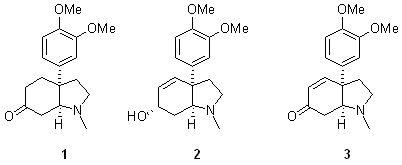 |
Mesembrine alkaloids from Narcissus triandrus L. |
 |
8th International Electronic Conference on Synthetic Organic Chemistry. ECSOC-8. 1-30 November 2004. http://www.lugo.usc.es/~qoseijas/ECSOC-8/
Julio A. Seijas,a* M. Pilar Vázquez-Tato,a* M. Teresa Linares,a Pablo Ramil-Rego,b M. Inmaculada Bujánb
aDepartamento de Química Orgánica. Universidad de Santiago de Compostela. Facultad de Ciencias. Campus de Lugo. Aptdo. 280. 27080-Lugo. Spain bDepartamento de Biología Vegetal. Universidad de Santiago de Compostela. Campus de Lugo. Aptdo. 280. 27080-Lugo. Spain.
Narcissus plants are known to contain amaryllidaceae alkaloids[1]. In fact there is a large number of phytochemical studies on Narcissus to check their use as potential source of galanthamine, an alkaloid with biological properties as healing in Alzheimer's disease, probably due to its acetylcholinesterase and muscarinic activity[vvv]. As a part our studies on the phytochemistry of endangered plants from Galicia (NW Spain), here we present the results for Narcissus triandrus L. collected from Serra do Xistral (fig. 1).
Figure 1
N. triandrus L. has its habitat extended over N.W. France, Portugal and
Spain. To our knowledge[2] there is only one phytochemical study on this plant (garden
varieties)[3], where haemanthamine, lycorenin, lycorin, homolycorin,
galanthamin and tazetin are identified.
The aereal parts of Narcissus triandrus were
extracted with methanol in a Soxhlet apparatus. The basic extracts were
purified by column chromatography with silica gel as adsorbent. Three mesembrine-type of
alkaloids were identified: mesembrine (1), mesembrenol (2) and
mesembrenone (3), this
last one in a very small amount. All were characterized on
the basis of their spectroscopic properties.However, none of the
previously described alkaloids were found.

Figure 2
| mesembrine | mesembrenol |
Up to now only three amaryllidaceae plants (Hymenocallis arenicola[4], Crinun oliganthum[5] and Narcissus pallidulus,[6]) were described to have Sceletium-type alkaloids (Aizoeceae).
Mesembrine and analog compounds are serotonin-uptake inhibitors[7] and can be used for the treatment of depressive states, psycological or psychiatric disorder with an anxiety component, alcohol and drug dependence, bulimia nervosa and obsessive-compulsive disorders. Those compounds are also the main component of Sceletium plants that have been used in traditional medicine by Khoisan of South Africa to prepare "kougoed" a fermentative preparation with narcotic-anxyolitic properties.[8]
Acknowledgements
XUNTA DE GALICIA for financial support: PGIDT01PXI26203PR and PR405 A
098/59-0.
REFERENCES
1.- Jin, Z. Nat. Prod. Rep. 2003, 20, 606–614. Hoshino, O. The Alkaloids Vol. 51 p.323-424, Academic Press 1998.
2.- SciFinder, 29th October 2004
3.- Boit, H. G.; Stender, W.; Beitner, A. Chem. Ber. 1957, 90, 725-728.4.- Doepke, W.; Sewerin, E.; Trimino, Z. Z. Chem. 1980, 20, 298-299, Chem. Abstr. 94:30972 1981.
5.- Doepke, W.; Sewerin, E.; Trimino, Z.; Gutiérrez, C. Z. Chem. 1981, 21, 358, Chem. Abst. 96:3654 1982.
6.- Bastida, J.; Viladomat, F.; Llabres, J. M.; Ramirez, G.; Codina, C.; Rubiralta, M.. J. Nat. Prod. (1989), 52(3), 478-80.
7.- Gericke, N. P.; Van Wyck, B. E., US Patent US6,288,104, 2001.
8.- Smith, M. T.; Crouch, N. R.; Gericke, N.; Hirst, M. J. Ethnopharmacology 1996, 50, 119-130. Smith, M. T.; Field, C. R.; Crouch, N. R.; Hirst, M. Pharm. Biol.1998, 36, 173-179.
